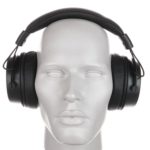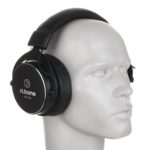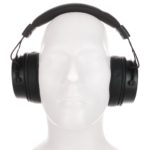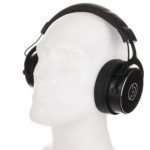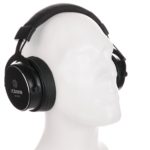The t.bone HD 815 impressed us. When mixing, they were particularly suitable for working on sound with distorted guitars in rock and metal. However, we advise caution when mixing pop vocals. As recording headphones, these score highly with their closed design. And their easy handling and comfortable fit make them a versatile workhorse.
- Well suited for guitar music
- Warm sound
- Good sound insulation to the outside
- Comfortable to wear
- Frequency range of vocals strongly emphasised
The t.bone HD 815 are closed-back, circumaural headphones designed to assist with recording and mixing. As the demands here are high and the competition is strong, we can’t wait to see how this contender from Musikhaus, Thomann’s own brand, performs in our practical test. At this point, we can anticipate this much: These headphones are a real surprise.

The t.bone HD 815 package
A look inside the box of the t.bone HD 815 reveals a well-organised package. In addition to the headphones, you will find an interchangeable cable with mini jack plugs and a screw adapter included. All plugs and the adapter are gold-plated and, therefore, well protected against corrosion. The straight cable is covered in fabric and gives an impression of high quality. Generous bend protectors at both ends prevent potential cable breakage.
Construction, material and technology of the t.bone HD 815
The t.bone HD 815 is an over-ear model dominated by the colour black. A shiny silver metal ring and greyish-white lettering provide the accents. The styling of these headphones makes them look like a professional tool. The metal arms of the headband appear solid. I noticed one small thing about the ear pads: their circumferential edge has a seam that is least visible when they are at the lower end of the closed ear cups. However, straight from the box, these were at the top on both sides and were, therefore, clearly visible. I quickly turned them around so they were at the bottom, and I was immediately satisfied with the details of the design.
Dynamic 50mm drivers work inside these headphones. They produce bass down to frequencies as low as 10 Hertz. In the treble range, they deliver sound up to 35 kHz. This means that these headphones exceed typical human hearing in both the low and high frequencies. In terms of sound pressure, the t.bone HD 815 can reach up to 97.3 dB SPL. This should be sufficient for the vast majority of recording and mixing situations. They have a low impedance so that they can also play loudly on headphone outputs that only deliver a fairly low output voltage. On average, it was only 34.8 ohms. This makes them suitable for working with audio interfaces and laptops.
The handling of the t.bone HD 815
The cable’s mini jack plug fits into the t.bone HD 815 using a locking mechanism. A small quarter turn prevents the cable from slipping out. The one-sided cable routing of these headphones is ideal for everyday recording and studio use. Right-handed users will have plenty of freedom of movement. The cable also offers a large working radius with a length of 3m.
When putting the headphones on, the size of the headband can be easily adjusted. The size adjustment is notched, so the headphones remember the last setting. This makes it easier to frequently put them on and take them off. The ear pads are generously sized and offer enough space even for larger ears.
These headphones weigh 313 grams without the cable and just 52 grams more with the cable included. This not only makes them wonderfully light to wear on your head, but it also means that, correspondingly, little pressure is required to ensure a secure fit. But hold on! When we measured the contact pressure, it was in the lower mid-range. However, the padding on the ear cups and headband was exemplary. They cushion the pressure of the headband so well that these headphones don’t cause headaches, even during long listening sessions. Having said that, the artificial leather can lead to sweaty ears during prolonged use. The handling of these headphones made a consistently good impression on me because they were suitable for everyday use.
The sound of the t.bone HD 815
Even if it sounds like a contradiction in terms to say that the HD 815 sounded “warm” to me despite sharp highs – the restrained super high-frequency range made this possible. They have a strong frequency range of around 300 Hz, and this certainly adds to this. These headphones have restrained transient reproduction, which also plays a role in their sonic warmth. The headphones’ mid-range resolution was a big surprise, especially when it came to rock and metal. Not many headphones are able to handle guitar mixes. Considering that we’re not dealing with a high-end model here, they did an excellent job!
When the upper mids and highs kicked in when listening to pop music with the HD 815, they started to become comparatively loud and superficial. If you are mixing dance, pop or hip hop with these headphones, then you are likely to deliver mixes where vocals seem rather subtle without a long period of familiarisation. To avoid this, the HD 815 required some counter-intuitive work. However, if you have studio experience, you will know that this characteristic can also be utilised to your advantage when mixing. If the upper mids and highs don’t sound too sharp when listening with the HD 815, the mix engineer has probably found the right balance.
When recording, some musicians want a high volume on the headphones to feel the energy of the music. This is not a problem with the HD 815; they can play wonderfully loudly without distortion. In recording situations, they benefit from good acoustic isolation from the outside. Therefore, crosstalk should not cause any major problems when making microphone recordings.
In terms of subjective signal resolution, tonal depth and stereo impression, these headphones offered an uneventful mid-range. So, we found absolutely nothing to complain about.
Conclusion
The closed-back t.bone HD 815 are a pair of headphones that can simplify recording and mixing, but it’s important to know what they can and can’t do. If you are looking for extremely affordable recording headphones, you will find they provide good, simple handling, a comfortable fit for longer sessions and a warm sound. In terms of sound, they are particularly suitable for mixing rock and metal. Care should be taken when mixing pop vocals, as the sound can quickly become sharp. When recording, these headphones can be a great help with their combination of high volume and good isolation from the outside.
Technical specifications
- Ear couplingOver-ear
- Typeclosed
- Transducer principledynamic
- Frequency response (headphones)10 - 35.000 Hz
- Impedance34,8 ohms
- Sound pressure level (SPL)97,3 dB
- Pressure averaged from big and small head639 g
- Weight with cable365 g
- Weight without cable313 g
- Cable length300 cm
What's in the box
- Interchangeable cable
- 6.35mm stereo jack












